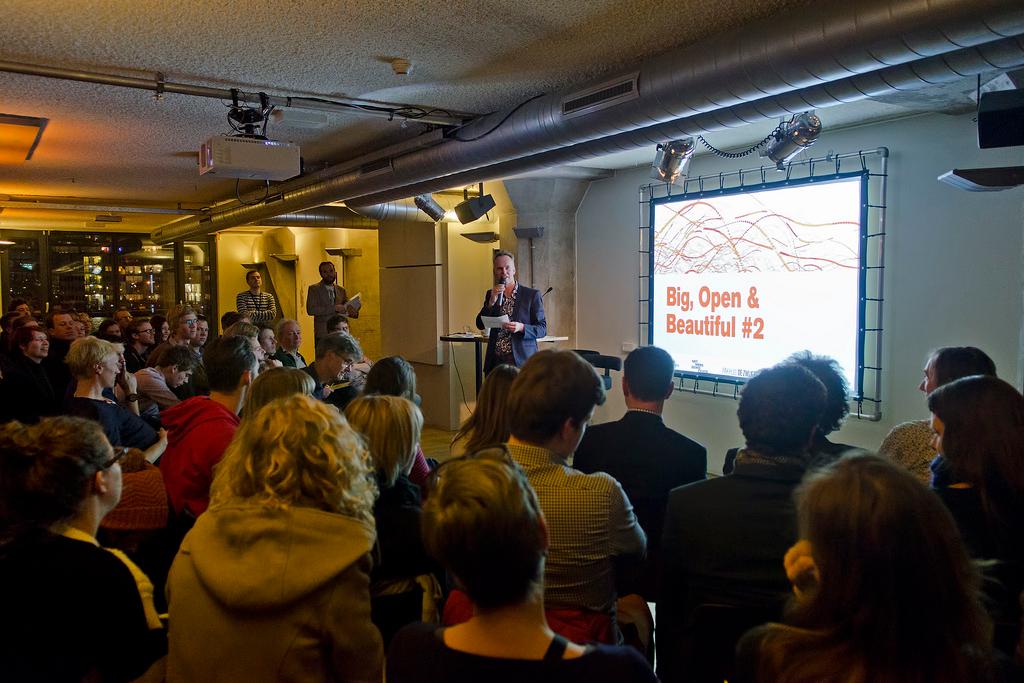During the second edition of the series ‘Big, Open & Beautiful: All about data’ we focused on data journalism: Mesmerizing, mobilizing or misleading? A journalist, blogger, researcher and Twitter-expert shared their views on data-analysis and storytelling with us.
The journalist
Nu.nl Editor Wouter Bax points to his colleague Jerry, who is sitting in the audience: “This is what a data journalist looks like”, he jokes. “As a data journalist, you have to understand IT, be an investigator and you have be able to tell the story. I’m honestly not sure if I am nerd enough for the job.” Wouter wants to give data journalism a place in the newsroom: “With this form of journalism you can extract new stories from existing facts. It is a new source of news.” Jerry explains what data journalism means for him: “I am not a Nate Silver, the guy that predicts US election outcomes. I cannot make predictions, I can only try to explain what happened based on the data I have.”
The blogger
Stephan Okhuijsen is a blogger for e.g. Sargasso, who analyses data in his spare time. “My curiosity is the most important driver for finding new stories and digging in the data. I once got a dataset containing information about 1 million soccer games and thought: Yes, there has got to be a story in this! I tortured the data for half a year and nothing happened. These kinds of disappointments are part of the job.” But the opposite is also true. “I found out by accident that people born in 1944 and 1945, the height of WWII, spend more on medicine. You might conclude that they still experience after-effects from the lack of good food in this period. So sometimes, looking at the data really reveales new stories.”
The researcher
Thomas Boeschoten was part of the Project X Haren research team. “You have a certain power when you interpret data”, is one of his first statements. “I have experienced this for myself, when I provided a friend with some facts about the riots. He needed them because he was going to talk about it at the Dutch TV show De Wereld Draait Door. I told him that mass media had contributed most to the hype leading up to the riots, but I made the mistake of basing this statement only on Twitter. Had I also looked at Facebook, my conclusion would have been very different.” He states that a story should always be based on several sources. “If you only look at the media-coverage of Project X, it comes across as a national event. Studying Facebook and Twitter shows us that, from the people involved, the majority just came from the North of Holland. And because 80% of the communications about project X was in fact face-to-face, you have to look at this as well if you want to discover the true story.”
The Twitter specialist
For the research 'Reading the Riots' by The Guardian, Farida Vis studied rumours about the London riots that spread via Twitter. “Remember that visualisation, a tool often used by data journalists to tell their story, is actually extreme data-reduction. You are throwing away 99% of your data and you are reading loads into the 1% that is left.” She emphasizes this fact strongly. “It is very dangerous to over read things into the data. A text can’t tell me why somebody did something, only that it happened.” She is currently looking into the behaviour of the English police on Twitter. “Researchers have to move beyond analysing only Tweets with a hash tag, as is done now. We should also use Tweets without a hash tag and take pictures or movies into account. They contain very valuable information.”
Look at all the pictures of the evening here.


